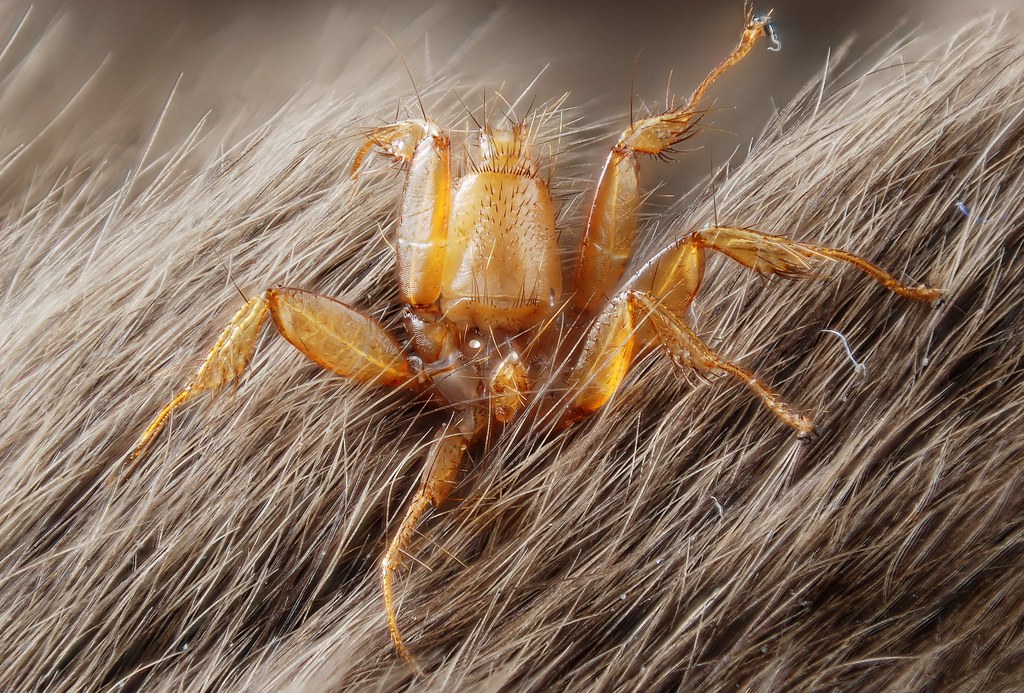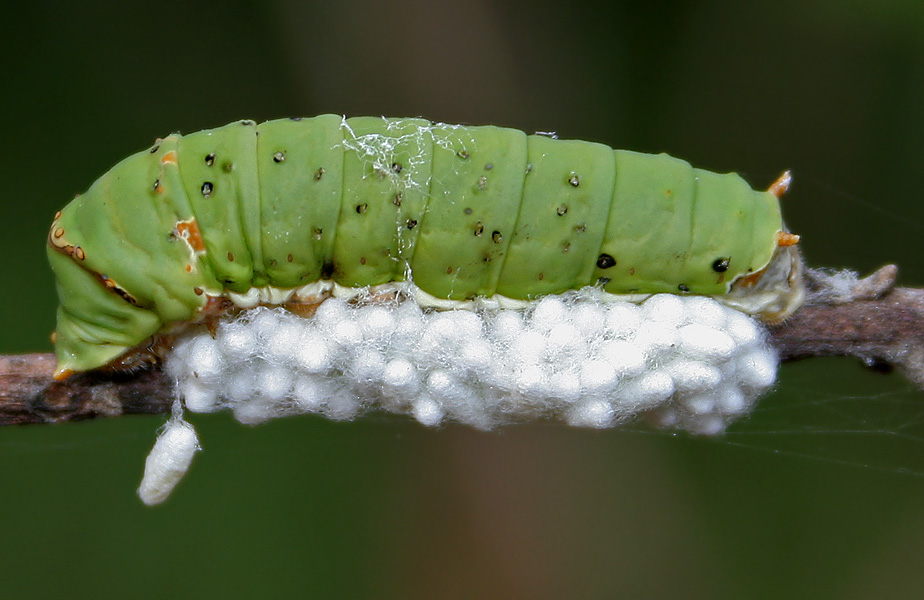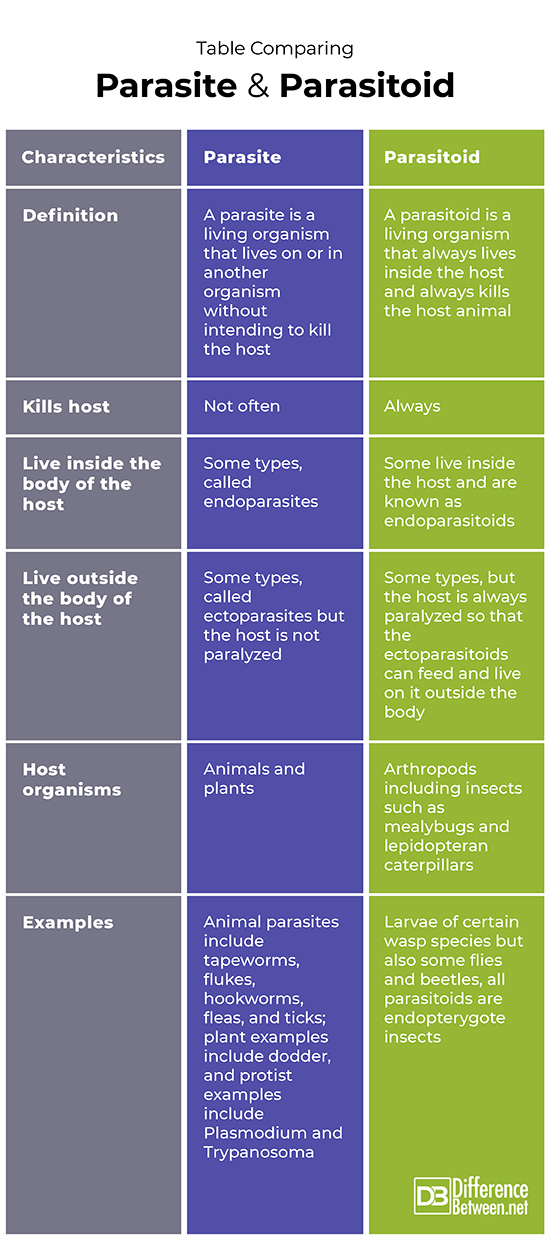Difference Between Parasite and Parasitoid
A parasite is an organism that lives in or on a host but does not kill the host. A parasitoid is an organism that lives on or inside a host and always kills the host.
What is a Parasite?
Definition:
A parasite is any living organism that depends on another organism for food or shelter, and also causes harm to the host but does not intend to kill the host.
Properties:
A parasite can live inside a host when it is called an endoparasite, or can live outside of a host when it is called an ectoparasite. The parasitic organism, in general, does not directly kill the host but rather uses the host as a vessel for it to complete its life cycle. This means that the parasite often is adapted to take just enough nutrients or use just enough space that the host survives even though it is weakened. In many cases a parasite has several hosts.
Types of organisms that are parasites:
Parasites occur in more than one kingdom of life, and in fact, both animals and plants can have parasites. Even humans can have parasites that can weaken the body.
Morphological adaptations of parasites:
Parasites often have morphological features that adapt them to their parasitic life style. For instance, the hookworm has cutting plates on the mouth end of the body so that it can hook into the gut wall and feed on host nutrients in the intestines. A hookworm is an endoparasite that lives inside the body. An ectoparasite like a louse has flattened legs with claws to attach to the hairs of the body. Fleas are another example of an ectoparasite, which has large hind legs for jumping and a flattened body.
Examples of parasites:
There are many examples of parasites, including hookworm, tapeworm, body lice, ticks, and fleas. In the plant kingdom there are plants that are parasites, such as the dodder which wraps around the host and uses structures called haustoria to attach directly to the vascular tissue of the host plant to obtain nutrients.
What is a Parasitoid?
Definition:
A parasitoid is an organism that always lives inside or on a host and kills the host at some stage of the parasitoid life cycle.
Properties:
Parasitoids often lay eggs inside or on the outside of the body of the host. The eggs then hatch and the larval stage proceeds to feed on the living host. The most numerous parasitoids are found in the insect order Hymenoptera, and it is not unusual for several pupal cases of wasps to be found on the corpse of a caterpillar host, for instance. A parasitoid often has only one host and is therefore very specific.
Types of organisms that are parasitoids:
Parasitoids are found in the insects that are endopterygotes; in other words they have a pupal stage present in the life cycle. Often the larva is the stage that feeds on the host.
Morphological adaptations of parasitoids:
Parasitoids are often adapted for laying their eggs onto or into the body of a host arthropod. For instance, the ovipositor of a wasp is able to penetrate through the cuticle of a host insect. The legs then hatch inside the host and larvae develop and grow until ready to pupate at which point they exit the host body and pupate on the outside. At this stage the host insect dies.
Examples of parasitoids:
Hymoptera, Diptera and Coleoptera are the orders that have parasitoids. Of these three groups of insects, the most parasitoids occur in the wasps, one of the groups of insects found in the Hymnoptera.
Difference between Parasite and Parasitoid?
Definition
A parasite can be defined as a living organism that lives on or inside a host but does not usually kill the host. A parasitoid can be defined as a living organism that lives on or inside of a host organism and always kills the host.
Kills host
A parasite may indirectly cause the death of a host, but this is not normally the case. A parasitoid always directly causes the host organism to die.
Live inside the body of the host
Some parasites live inside the body of the host organism and are called endoparasites. Some parasitoids do live inside the body and are known as endoparasitoids.
Live outside the body of the host
Certain of the parasites are called ectoparasites because they live on the outside of the host’s body. Certain parasitoids are ectoparasitoids since they live outside of the body of the host.
Host organisms
Many species of animals and plants are the hosts of numerous species of parasites. Only species of arthropods are hosts to parasitoid organisms.
Examples
Animal parasites include such examples as roundworms, tapeworms, flukes, hookworms, fleas, and ticks; plant parasites include dodder, and a protist parasite includes Plasmodium. Arthropod parasitoids include mainly insects that are all in the endopterygotes and include individuals in the order Hymenoptera, but also a few in the Diptera and Coleoptera.
Table Comparing Parasite and Parasitoid
Summary of Parasite Vs. Parasitoid
- Parasites and parasitoids are both living organisms that can live in or on a host.
- Parasites do not intentionally kill the host while parasitoids do.
- Parasitoids are insects while parasites include several animals, protists and some plants.
- Difference Between Rumination and Regurgitation - June 13, 2024
- Difference Between Pyelectasis and Hydronephrosis - June 4, 2024
- Difference Between Cellulitis and Erysipelas - June 1, 2024
Search DifferenceBetween.net :
Leave a Response
References :
[0]Arai, Hisao, ed. Biology of the tapeworm Hymenolepis diminuta. Elsevier, 2012.
[1]Heng-Moss, Tiffany, Frederick Baxendale, and Terrance Riordan. "Interactions between the parasitoid Rhopus nigroclavatus (Ashmead)(Hymenoptera: Encyrtidae) and its mealybug hosts Tridiscus sporoboli (Cockerell) and Trionymus sp.(Homoptera: Pseudococcidae)." Biological Control 22.3 (2001): 201-206.
[2]Li, Junmin, Zexin Jin, and Wenjing Song. "Do native parasitic plants cause more damage to exotic invasive hosts than native non-invasive hosts? An implication for biocontrol." PLoS One 7.4 (2012).
[3]Image credit: https://commons.wikimedia.org/wiki/File:Braconid_parasitoid_wasp_Apanteles_sp_eggs_%26_Lime_Butterfly_(Papilio_demoleus)_cat_W_IMG_2862.jpg
[4]Image credit: https://live.staticflickr.com/4085/5021769088_3e7fffe9fc_b.jpg



